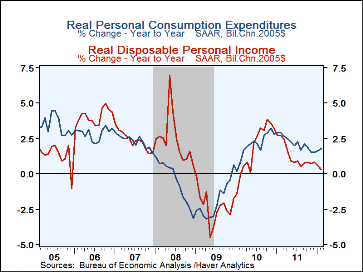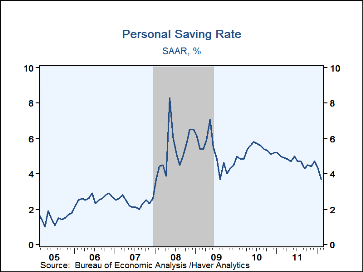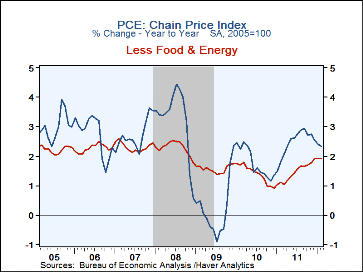 Global| Mar 30 2012
Global| Mar 30 2012U.S. Personal Income Gain Is Disappointing And Savings Decline
by:Tom Moeller
|in:Economy in Brief
Summary
Personal income increased just 0.2% during February after lessened gains of 0.2% and 0.4% during the prior two months. The latest rise missed expectations for a 0.4% gain. Wage & salary disbursements reflected the improved gains in [...]
 Personal income increased just 0.2%
during February after lessened gains of 0.2% and 0.4% during the prior two
months. The latest rise missed expectations for a 0.4% gain. Wage &
salary disbursements reflected the improved gains in payroll employment
with a 0.3% rise (4.4% y/y). However, the firm gain was offset by another
dip in interest income (-3.1% y/y) and just a 0.1% rise (1.0% y/y) in
transfer receipts. Disposable personal income rose 0.2% (2.6% y/y)
although take-home pay, when adjusted for price inflation, slipped 0.1%
(+0.3% y/y), down for the third month in the last four.
Personal income increased just 0.2%
during February after lessened gains of 0.2% and 0.4% during the prior two
months. The latest rise missed expectations for a 0.4% gain. Wage &
salary disbursements reflected the improved gains in payroll employment
with a 0.3% rise (4.4% y/y). However, the firm gain was offset by another
dip in interest income (-3.1% y/y) and just a 0.1% rise (1.0% y/y) in
transfer receipts. Disposable personal income rose 0.2% (2.6% y/y)
although take-home pay, when adjusted for price inflation, slipped 0.1%
(+0.3% y/y), down for the third month in the last four.
Despite these disappointments consumers kept spending. Personal consumption expenditures jumped 0.8% (4.1% y/y), their strongest gain in a year. Earlier figures were revised upward. Expectations had been for a 0.6% rise. The increase was driven by a 3.9% rise (2.6% y/y) in spending on gasoline, a 3.3% gain (9.5% y/y) in motor vehicles and a 1.2% increase (4.4% y/y) in clothing. Spending on recreation also rose a firm 0.9% (7.5% y/y). The rise in gasoline outlays actually translated into a 7.0% y/y decline when adjusted for higher prices. Overall, when adjusted for inflation real PCE increased 0.5% (1.8% y/y), the best gain since June.
All this spending came at the expense of savings. The personal savings rate fell to 3.7% from a downwardly revised 4.3% during January. It remained below the 5.0% level twelve months ago and a 2010 monthly high of 5.8%.
The PCE chain price index rose 0.3% last month (2.3% y/y), the strongest increase since August. The increase reflected a 5.7% rise (10.4% y/y) in gasoline prices after a 0.9% January rise. The core PCE price index ticked up 0.1% and the y/y increase of 1.9% was up from the record low 12-month change of 0.9% reached last December.
The personal income & consumption figures are available in Haver's USECON and USNA databases. The expectations figures are in the AS1REPNA database.
Okun's Law and Long Expansions from the Federal Reserve Bank of New York is available here.
| Personal Income & Outlays(%) | Feb | Jan | Dec | Y/Y | 2011 | 2010 | 2009 |
|---|---|---|---|---|---|---|---|
| Personal Income | 0.2 | 0.2 | 0.4 | 3.2 | 5.1 | 3.7 | -4.3 |
| Wages & Salaries | 0.3 | 0.4 | 0.4 | 4.4 | 4.3 | 2.2 | -4.3 |
| Disposable Personal Income |
0.2 | 0.0 | 0.4 | 2.6 | 3.8 | 3.6 | -2.1 |
| Personal Consumption Expenditures |
0.8 | 0.4 | 0.2 | 4.1 | 4.7 | 3.8 | -1.7 |
| Personal Saving Rate | 3.7 | 4.3 | 4.7 | 5.0 (Feb'11) |
4.7 | 5.3 | 5.1 |
| PCE Chain Price Index | 0.3 | 0.2 | 0.1 | 2.3 | 2.5 | 1.8 | 0.2 |
| Less Food & Energy | 0.1 | 0.2 | 0.2 | 1.9 | 1.4 | 1.4 | 1.6 |
| Real Disposable Income |
-0.1 | -0.2 | 0.3 | 0.3 | 1.3 | 1.8 | -2.3 |
| Real Personal Consumption Expenditures |
0.5 | 0.2 | 0.1 | 1.8 | 2.2 | 2.0 | -1.9 |
Tom Moeller
AuthorMore in Author Profile »Prior to joining Haver Analytics in 2000, Mr. Moeller worked as the Economist at Chancellor Capital Management from 1985 to 1999. There, he developed comprehensive economic forecasts and interpreted economic data for equity and fixed income portfolio managers. Also at Chancellor, Mr. Moeller worked as an equity analyst and was responsible for researching and rating companies in the economically sensitive automobile and housing industries for investment in Chancellor’s equity portfolio. Prior to joining Chancellor, Mr. Moeller was an Economist at Citibank from 1979 to 1984. He also analyzed pricing behavior in the metals industry for the Council on Wage and Price Stability in Washington, D.C. In 1999, Mr. Moeller received the award for most accurate forecast from the Forecasters' Club of New York. From 1990 to 1992 he was President of the New York Association for Business Economists. Mr. Moeller earned an M.B.A. in Finance from Fordham University, where he graduated in 1987. He holds a Bachelor of Arts in Economics from George Washington University.








